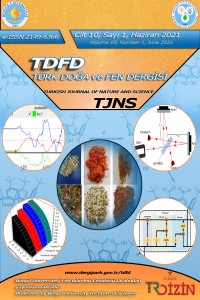Geopolimer Beton ve Geleneksel Beton Üretim Süreçlerinden Kaynaklı CO2 Salınımının Metasezgisel Yöntemlerle Belirlenmesi
Öz
Bu çalışmada, metasezgisel algoritmalardan öğretme-öğrenme tabanlı optimizasyon (TLBO) ve çiçek tozlaşma algoritması (FPA) kullanılarak; geopolimer beton ve geleneksel beton üretim süreçlerinden kaynaklı CO2 salınımı karşılaştırması; betonarme kolon, kiriş ve tekil temel tasarımı üzerinden yapılmıştır. Optimizasyonun amacı; tasarım şartlarına uygun bir şekilde, betonarme malzemeleri üretim süreçlerinden kaynaklı minimum CO2 emisyonu verecek boyutlandırmayı bulmaktır. Optimum tasarımlar, geleneksel beton kullanılması ve geopolimer beton kullanılması durumlarına göre ayrı ayrı irdelenmiştir. Çalışma sonucunda, betonarme eleman üretimi sırasında, geleneksel beton yerine geopolimer betonun kullanımının CO2 emisyon miktarının %40-%58 arasında düşürdüğü tespit edilmiştir.
Anahtar Kelimeler
CO2 emisyonu geopolimer beton geleneksel beton öğretme-öğrenme tabanlı algoritma çiçek tozlaşma algoritması
Kaynakça
- Climate action and support trends; 2019. United Nations: Climate Change.
- He Z, Zhu X, Wang J, Mu M, Wang Y. Comparison of CO2 emissions from OPC and recycled cement production. Elsevier: Construction and Building Materials. 2019;211: 965-973.
- Energy Efficiency and CO2 Reduction in the Iron and Steel Industry; 2019. European Commission.
- Davidovits J. Environmentally Driven Geopolymer Cement Applications, Geopolymer 2002 Conference. Melbourne: 2002. p.145-156.
- Shayan A, Xu A, Phaedonos AF. Field performance of geopolymer concrete, used as a measure towards reducing carbon dioxide emission. Materials Science. 2013;3:245-52.
- Mishra G. [Internet]; 2014 [cited 2019 December 3] Geopolymer Concrete – Properties, Composition and Applications. Available from: https://theconstructor.org/concrete/geopolymer-concrete-ecofriendly-construction-material/9430/
- Greenroofs [Internet]; 2015 [cited 2019 December]. Available from: https://www.greenroofs.com/projects/global-change-institute/
- Davidovits J. 30 Years of Successes and Failuresin Geopolymer Applications. Market Trends and Potential Breakthroughs, Geopolymer 2002 Conference. 2002. Melbourne: p.176-83.
- Hardjito D, Wallah SE, Sumajouw DMJ, Rangan V. On the Development of Fly Ash-Based Geopolymer Concrete. ACI Materials Journal. 2004;101(52): 467-472.
- Geopolymer. [Internet]; 2016 [cited 2019 December 3]. Available from: https://www.geopolymer.org/applications/geopolymer-cement/
- Geopolymer. [Internet]; 2016 [cited 2019 December 3]. Available from: https://www.geopolymer.org/library/technical-papers/technical-paper-on-geopolymer-aircraft-pavement/
- Li C, Gong X, Cui S, Wang Z, Zheng Y, Chi B. CO2 Emissions due to Cement Manufacture, Material Science Forum. 2011;685: 181-187.
- Akçansa. [Internet];2018 [cited 2019 November 27]. Sürdürülebilirlik raporu 2016-2017. Available from: http://www.akcansa.com.tr/downloads/surdurebilirlik/AKC-surdurulebilirlikRapor-261118.pdf
- McLellan BC, Williams RP, Lay J, Riessen AV, Corder GD. Costs and carbon emissions for geopolymer pastes in comparison to ordinary portland cement. Journal of Cleaner Production. 2011;19(9-10): 1080-1090.
- Heuristic. [Internet]; 2015 [cited 2019 December 3]. Available from: https://en.wikipedia.org/wiki/Heuristic
- Blum C, Roli A. Metaheuristics in combinatorial optimization: overview and conceptual comparison. ACM Computing Surveys. 2001;35: 268-308.
- Rao RV, Savsani VJ, Vakharia DP. Teaching–learning-based optimization: A novel method for constrained mechanical design optimization problems. Computer-aided Design. 2011;43: 303-315.
- Rao RV. Review of applications of TLBO algorithm and a tutorial for beginners to solve the unconstrained and constrained optimization problems. Decision Science Letters. 2016;5: 1-30.
- Dede T. Optimum design of grillage structures to LRFD-AISC with teaching-learning based optimization. Structural and Multidisciplinary Optimization, – Springer. 2013; 48:955–964.
- Temür R, Bekdaş G. Teaching learning-based optimization for design of cantilever retaining walls. Structural Engineering and Mechanics. 2016; 57(4): 763-783.
- Dede T, Ayvaz Y. Structural optimization with teaching-learning-based optimization algorithm. Structural Engineering and Mechanics - koreascience.or.kr. 2013; 495-511.
- Aydogdu I, Akin A. Teaching and learning-based optimization algorithm for optimum design of steel buildings. International Conference on Computing in Civil and Building Engineering, 2014. Reston, Virginia: ASCE; 2014. p. 2167-2175.
- Toğan V. Design of planar steel frames using teaching–learning based optimization. Engineering Structures - Elsevier. 2012; 34: 225-232.
- Degertekin SO, Hayalioglu MS. Sizing truss structures using teaching-learning-based optimization. Computers & Structures - Elsevier. 2013; 119: 177-188.
- Akin A, Aydogdu I. Optimum design of steel space frames by hybrid teaching-learning based optimization and harmony search algorithms. International Journal of Mechanical, Aerospace, Industrial, Mechatronic and Manufacturing Engineering. 2015; 9(7): 1318-1325.
- Daloglu AT, Artar M, Ozgan K, Karakas Aİ. Optimum design of braced steel space frames including soil-structure interaction via teaching-learning-based optimization and harmony search algorithms. Advances in Civil Engineering - Hindawi.com. 2018.
- Yang XS. Flower pollination algorithm for global optimization. Unconventional Computation and Natural Computation. 2012; 7445:240-249.
- Nigdeli SM, Bekdaş G, Yang XS. Application of the flower pollination algorithm in structural engineering. Metaheuristics and Optimization in Civil Engineering – Springer. 2016; 25-42.
- Mergos PE, Mantoglou F. Optimum design of reinforced concrete retaining walls with the flower pollination algorithm. Structural and Multidisciplinary Optimization – Springer. 2020; 61: 575-585.
- Nigdeli SM, Bekdaş G, Yang XS. Metaheuristic optimization of reinforced concrete footings. KSCE Journal of Civil Engineering – Springer. 2018; 22: 4555-4563.
- Roh S, Tae S, Suk SJ, Ford G, Shin S. Development of a building life cycle carbon emission sassesment program (BEGAS2.0) for Korea'sgreen building index certification system. Renewable and sustainable energy reviews. 2016;53:954-965.
Ayrıntılar
| Birincil Dil | Türkçe |
|---|---|
| Konular | Mühendislik |
| Bölüm | Makaleler |
| Yazarlar | |
| Yayımlanma Tarihi | 25 Haziran 2021 |
| Yayımlandığı Sayı | Yıl 2021 Cilt: 10 Sayı: 1 |
Kaynak Göster
Bu eser Creative Commons Atıf-GayriTicari-Türetilemez 4.0 Uluslararası Lisansı ile lisanslanmıştır.


